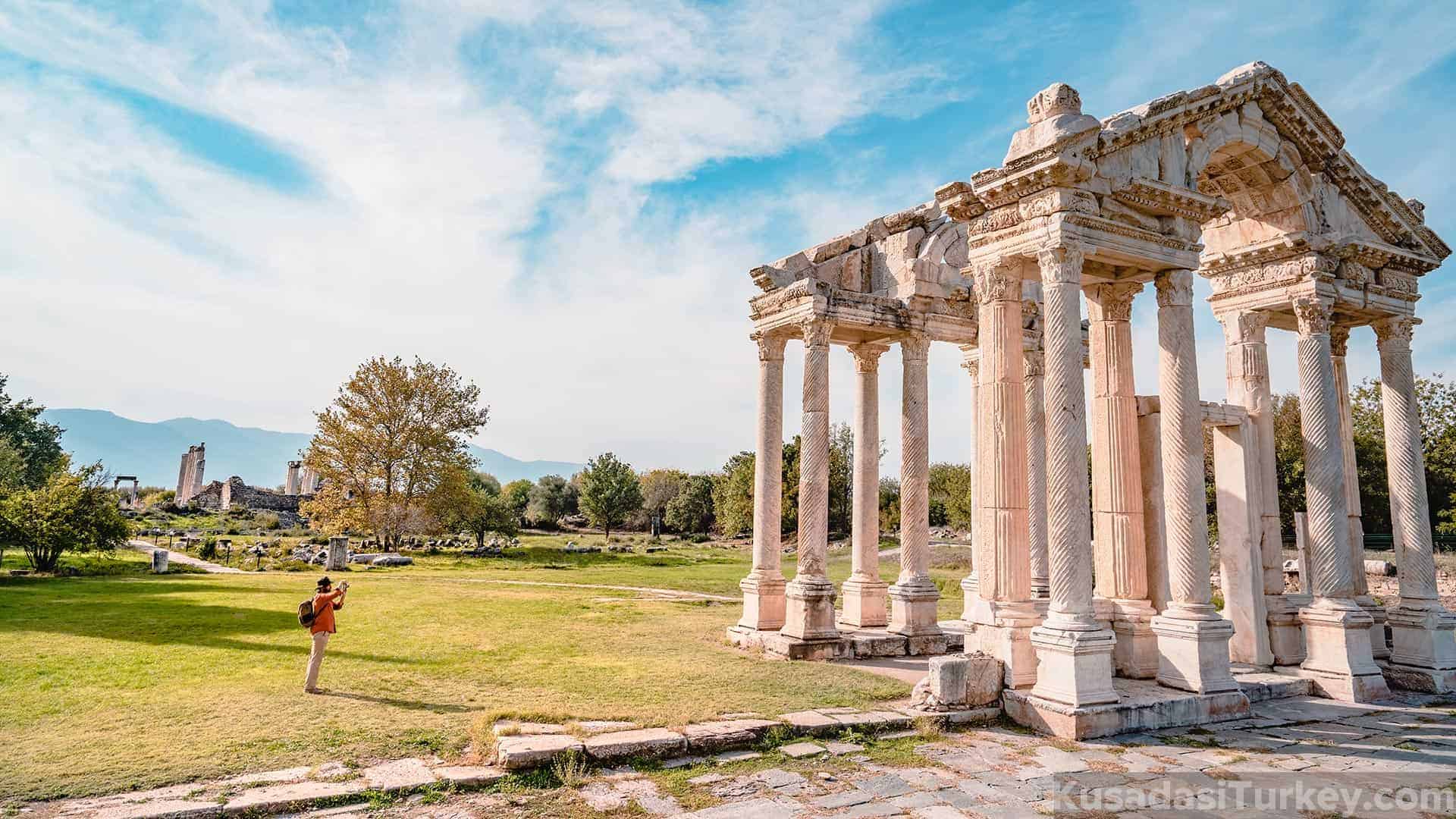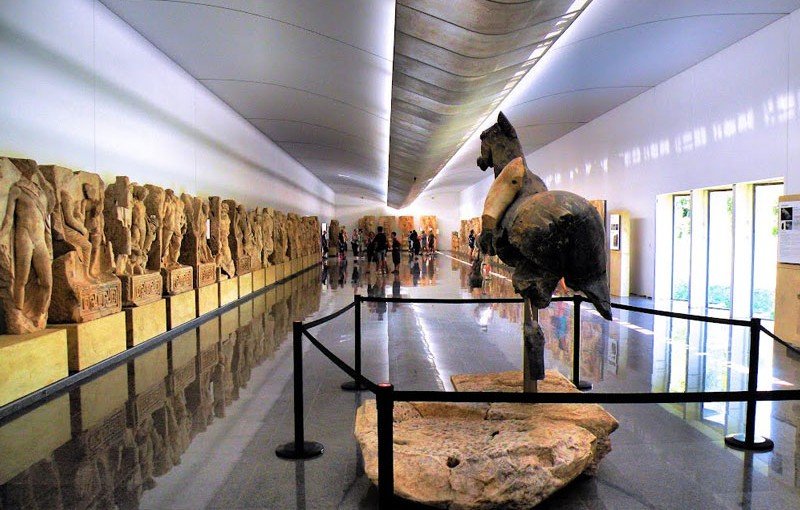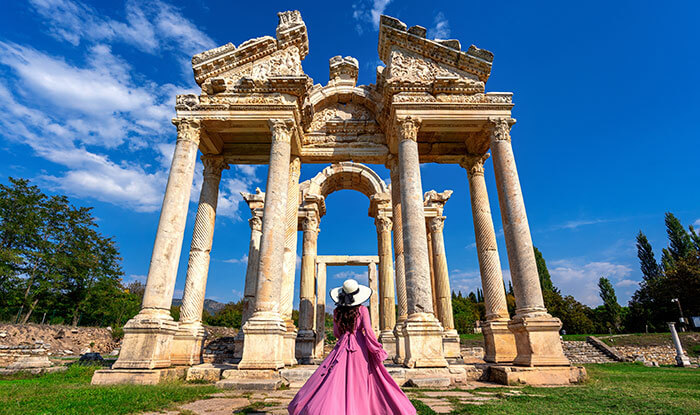Unearth Ancient Wonders: Aphrodisias, Turkey's Hidden Gem

Introduction to Aphrodisias, Turkey
Overview of Aphrodisias history and significance
Aphrodisias, located in Turkey, holds a rich historical significance as an ancient city dedicated to Greek mythology's goddess Aphrodite, the goddess of love and beauty. The city flourished during the Roman and Byzantine periods, known for its intricate sculptures and impressive architecture. The site served as a centre for the arts, philosophy, and sports, particularly renowned for its sculptors and marble quarries that produced exquisite artworks.
Location and accessibility of Aphrodisias
Visiting Aphrodisias today offers a glimpse into its fascinating past. Nestled in the fertile Meander River valley in Western Turkey, the archaeological site is surrounded by picturesque landscapes. The closest major city to Aphrodisias is Denizli, which is approximately 100 kilometres away. Travelers can reach Aphrodisias by road, with options for guided tours or independent exploration. The well-maintained site makes it easy for visitors to wander among the ancient ruins and imagine life as it once thrived in this historical hub.

Aphrodisias Archaeological Site
Exploring the Aphrodisias Temple of Aphrodite
When you explore the Aphrodisias Temple of Aphrodite, you are stepping into a place where ancient worshippers once paid homage to the goddess of love and beauty. The temple's grandeur and architectural beauty testify to the devotion and craftsmanship of the people of that era. As you walk through its ruins, you can almost feel the spiritual energy that once filled the air, connecting you to the past profoundly.
Visiting the Aphrodisias Stadium
As you visit the Aphrodisias Stadium, you can envision the excitement and energy that once filled the air during ancient sports events and competitions. The stadium's impressive structure and seating arrangements represent the city's passion for sports and entertainment. Standing on the grounds where athletes once competed, you can almost hear the echoes of cheers and applause that rang through the stadium, bringing the past glory of Aphrodisias back to life.

Aphrodisias Museum
Highlights of the Aphrodisias Museum collection
When you step into the Aphrodisias Museum, you are greeted by a treasure trove of artefacts that offer a glimpse into this ancient city's rich history and culture. The museum's collection includes intricately carved sculptures, delicate pottery, and exquisite jewellery, each telling a story of the people who once called Aphrodisias home. From statues of mythological figures to everyday objects used by the inhabitants, every exhibit showcases the artistry and skill of the artisans of that time.
Touring the sculptures and artefacts in the museum
As you wander through the halls of the Aphrodisias Museum, you will be mesmerized by the sheer beauty and detail of the sculptures and artefacts on display. Each piece has been carefully preserved and curated to offer visitors a glimpse into the daily life and beliefs of the ancient Aphrodisiacs. Whether you are admiring the graceful curves of a marble statue or marvelling at the intricate patterns on a piece of pottery, each artefact transports you back to an era of artistic brilliance and cultural richness. Take your time to soak in the history and craftsmanship that permeate every corner of this remarkable museum.

The Sebasteion of Aphrodisias
History and significance of the Sebasteion complex
When you visit the Sebasteion of Aphrodisias, you are stepping into a world where ancient mythology and religious significance intertwine. The Sebasteion was a grand architectural complex dedicated to the worship of the Roman emperors and the goddess Aphrodite. It served as a centre for religious ceremonies, imperial cult practices, and artistic expression. The intricate reliefs and sculptures that adorned the walls of the Sebasteion were a testament to the skill and devotion of the artisans who created them. Each carving told a story, whether it was a depiction of a mythological scene or a homage to a Roman emperor, showcasing the fusion of art and religion in ancient Aphrodisias.
Exploring the reliefs and sculptures at the Sebasteion
As you wander through the corridors of the Sebasteion, you will be captivated by the detailed reliefs and sculptures that line the walls. Each piece offers a window into the beliefs and values of the people who once revered this sacred site. From depictions of gods and goddesses to scenes of imperial grandeur, the artworks at the Sebasteion paint a vivid picture of the cultural tapestry of ancient Aphrodisias. Take your time to admire the craftsmanship and symbolism in each relief, and let yourself be transported to a time when art and devotion intertwined seamlessly.

The Hadrianic Baths
Overview of the Hadrianic Baths at Aphrodisias
When you enter the Hadrianic Baths at Aphrodisias, you are greeted by a glimpse into the ancient world of bathing rituals and leisure activities. The baths were a central hub for socializing, relaxation, and cleanliness for the people of Aphrodisias. Named after the Roman Emperor Hadrian, these baths were a testament to the luxurious lifestyle enjoyed by the city's elite citizens. As you explore the intricate layout of the baths, you can imagine the bustling atmosphere of the past, with people chatting, exercising, and rejuvenating themselves in the various chambers and pools.
Architectural features and design of the baths
The Hadrianic Baths boasted a sophisticated architectural design that reflected the Roman influence on the city of Aphrodisias. The complex included a series of interconnected rooms, such as the frigidarium (cold room), tepidarium (warm room), and caldarium (hot room), providing visitors with a range of temperature experiences. The baths were adorned with decorative elements like marble floors, intricate mosaics, and statues, creating a lavish ambience for bathers. The meticulous planning and engineering that went into the construction of the baths showcased the importance of communal bathing and social gatherings in ancient Aphrodisias.

Tetrapylon at Aphrodisias
Significance of the Tetrapylon structure
When you visit the Tetrapylon at Aphrodisias, you are met with a grand and symbolic gateway that once marked the intersection of two main streets in the ancient city. This ornate structure was a focal point for travellers and locals alike, guiding them towards the heart of Aphrodisias. The Tetrapylon's four impressive gateways, adorned with intricate carvings and sculptures, showcased the wealth and power of the city during its heyday. Standing tall and proud, the Tetrapylon acted as a symbol of Aphrodisias' influence and prosperity.
Detailed architecture and historical context
The Tetrapylon's architecture exuded elegance and sophistication, featuring four main pillars supporting a decorative entablature. Each gateway was richly decorated with reliefs depicting deities, mythological scenes, and imperial figures, emphasizing Aphrodisias' religious and political significance. The structure was constructed using fine marble and intricate stonework, highlighting the craftsmanship and artistry of the ancient builders. Historically, the Tetrapylon served as a meeting point for citizens, traders, and visitors, fostering community and connection in Aphrodisias.

Bouleuterion (Council House)
Exploring the ancient council chamber at Aphrodisias
When you step into the Bouleuterion at Aphrodisias, you are transported back to the seat of political and civic decision-making in the ancient city. The architecture of the Bouleuterion reflects a blend of functionality and grandeur, with its tiered seating arrangement and central stage, where important discussions and debates would have taken place. As you walk through the chamber, you can almost sense the echoes of voices from the past, discussing matters that shaped the city's destiny.
Function and historical importance of the Bouleuterion
The Bouleuterion served as the meeting place for the city council, where elected representatives deliberated on laws, policies, and other administrative matters crucial to Aphrodisias' governance. This structure played a vital role in maintaining order and democracy within the city, giving citizens a voice in decision-making processes. The historical significance of the Bouleuterion lies in its function as a hub of civic life, fostering communal participation and contributing to developing Aphrodisias as a thriving urban centre.

Aphrodisias Synagogue
History and architecture of the ancient synagogue
When you enter the magnificent Aphrodisias Synagogue, you are greeted by a breathtaking blend of history and architectural prowess. The structure exudes a sense of religious importance and community gathering with its intricate designs and sacred aura. The synagogue's layout speaks volumes about the cultural practices and beliefs of the people who once congregated within its walls. Each corner of the synagogue holds a story waiting to be unveiled, showcasing the craftsmanship and devotion of its builders.
Cultural significance of the Aphrodisias Synagogue
The Aphrodisias Synagogue stands as a testament to the rich cultural tapestry of ancient Aphrodisias, symbolizing the religious diversity and tolerance that characterized the city. It served as a place of worship and a communal centre where members of the local Jewish community could come together to pray, learn, and socialize. The synagogue's presence in Aphrodisias reflects the harmonious coexistence of different religious groups within the city, contributing to its reputation as a melting pot of traditions and ideas. As you explore the remnants of this sacred site, you can feel the echoes of spiritual devotion and communal unity that once permeated its halls.
